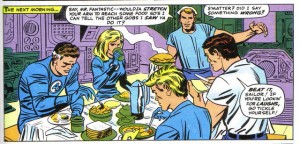You often hear old-timers praise the work of Jack "King" Kirby, arguably the most influential comics artist in history, but harder to find are explanations of why he was so great. Luckily we have Norris Burroughs of the "Jack Kirby Museum" to illuminate our ignorance.
One of Kirby's greatest strengths (although that's a bit like saying "One of the ocean's wettest waves -- the guy did so many things at such a high level it seems odd to pick out just one) was his panel composition, a skill sorely lacking in most comics. Burroughs does a great job explicating one such panel here:
In this panel from Fantastic Four #39, a conversation is taking place around a table.
(Click to embiggen.)The reader's eye enters the page with the visual cue of the yellow box reading, "the Next morning" and then on to the word balloon emanating from the sailor and finally comes to rest on the sailor himself. However, this is not the only cue to follow, as the structure of the entire composition will also lead us to the sailor. He is the apex of a pyramid that begins with the figure of Mr. Fantastic, travels rightward past Sue Storm to the top of the sailor's head, down his arm to Ben Grimm's shoulder and around left again to Johnny Storm. The oval shape moves the eye around, but the progression of a few moments in time must begin with Mr. Fantastic and end with Ben Grimm's words. This is a clear sequence of time in comic storytelling.
He doesn't post all that often, and the archives are only three pages deep, but he crams a ton of great stuff into those brief posts. Spend a lazy afternoon browsing through his breakdown of Kirby Kinetics and you'll thank me for pointing out this Thing I Like.
(Image from "Fantastic Four" number 39, © Marvel Entertainment Group.)


